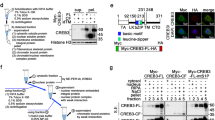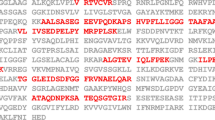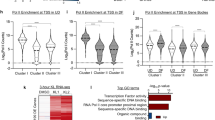Abstract
Inhibitor of differentiation/DNA binding (Id) proteins comprise a class of helix–loop–helix transcription factors involved in proliferation, differentiation, apoptosis, and carcinogenesis. We have shown that while Id2 is induced by UVB in primary keratinocytes, Id3 is upregulated only in immortalized cells. We have now determined that the consequences of ectopic expression of Id3 protein are strikingly different between immortalized and primary keratinocytes. Overexpression of Id3 induces a significant increase in apoptotic cells as revealed by Annexin V positivity as well as proteolytic processing of caspase-3 in immortalized, but not in primary keratinocytes. Id3-green fluorescent protein (GFP)-positive cells exhibited a fivefold increase in apoptotic nuclear fragmentation compared to Id3-GFP-negative cells. These apoptotic responses were accompanied by activation of caspase-3, as shown by immunocytochemical staining with antibodies to active caspase-3. Immunostaining with antibodies to the active form of caspase-9 as well as to the active form of Bax further revealed that induction of apoptosis in Id3-overexpressing keratinocytes occurred via a mitochondrial-caspase-9-mediated pathway. Coexpression of dominant-negative caspase-9 with Id3 significantly suppressed apoptotic nuclear fragmentation, indicating that caspase-9 activation is essential for Id3-induced cell death. This response was also markedly attenuated by coexpression with the Bax antagonist antiapoptotic protein Bcl2, confirming a role for Bax activation in this apoptotic response. Id3-induced Bax activation may result from increased expression of Bax protein. Furthermore, reduction of Id3 expression by small interfering RNAs abrogated the UVB-induced proteolytic activation of caspase-3 in these cells. These data together suggest that UVB-induced apoptosis of immortalized keratinocytes is at least in part due to Id3 upregulation in these cells.
This is a preview of subscription content, access via your institution
Access options
Subscribe to this journal
Receive 50 print issues and online access
$259.00 per year
only $5.18 per issue
Buy this article
- Purchase on Springer Link
- Instant access to full article PDF
Prices may be subject to local taxes which are calculated during checkout









Similar content being viewed by others
Abbreviations
- AK:
-
actinic keratosis (es)
- DN:
-
dominant-negative
- GFP:
-
green fluorescent protein
- HLH:
-
helix–loop–helix
- HPV:
-
human papillomavirus
- Id:
-
inhibitor of differentiation/DNA binding
- KC:
-
keratinocyte(s)
- RT–PCR:
-
reverse transcription–polymerase chain reaction
- SCC:
-
squamous cell carcinoma(s)
References
Alani RM, Hasskarl J, Grace M, Hernandez MC, Israel MA, Munger K . (1999). Proc Natl Acad Sci USA 96: 9637–9641.
Atchley WR, Fitch WM . (1997). Proc Natl Acad Sci USA 94: 5172–5176.
Backvall H, Asplund A, Gustafsson A, Sivertsson A, Lundeberg J, Ponten F . (2005). Mutat Res 571: 65–79.
Casciola-Rosen L, Nicholson D, Chong T, Rowan K, Thornberry N, Miller D et al. (1996). J Exp Med 183: 1957–1964.
Cleaver JE, Crowley E . (2002). Front Biosci 7: d1024–d1043.
Daher A, Simbulan-Rosenthal CM, Rosenthal DS . (2006). Exp Dermatol 15: 23–34.
Decraene D, Van Laethem A, Agostinis P, De Peuter L, Degreef H, Bouillon R et al. (2004). J Invest Dermatol 123: 207–212.
Fearnhead HO, Rodriguez J, Govek EE, Guo W, Kobayashi R, Hannon G et al. (1998). Proc Natl Acad Sci USA 95: 13664–13669.
Florio M, Hernandez MC, Yang H, Shu HK, Cleveland JL, Israel MA . (1998). Mol Cell Biol 18: 5435–5444.
Frost C, Williams G, Green A . (2000). J Invest Dermatol 115: 273–277.
Harvey I, Frankel S, Marks R, Shalom D, Nolan-Farrell M . (1996). Br J Cancer 74: 1302–1307.
Heisler GM, Grant RH, Gao W, Slusser JR . (2004). Photochem Photobiol 80: 422–428.
Iavarone A, Garg P, Lasorella A, Hsu J, Israel MA . (1994). Genes Dev 8: 1270–1284.
Kee BL, Rivera RR, Murre C . (2001). Nat Immunol 2: 242–247.
Koyama T, Suzuki H, Imakiire A, Yanase N, Hata K, Mizuguchi J . (2004). Anticancer Res 24: 1519–1524.
Lasorella A, Iavarone A, Israel MA . (1996). Mol Cell Biol 16: 2570–2578.
Liu J, Shi W, Warburton D . (2000). Biochem Biophys Res Commun 273: 1042–1047.
Marks R, Foley P, Goodman G, Hage BH, Selwood TS . (1986). Br J Dermatol 115: 649–655.
Marks R, Rennie G, Selwood TS . (1988). Lancet 1: 795–797.
Massari ME, Murre C . (2000). Mol Cell Biol 20: 429–440.
Mitchell KO, Ricci MS, Miyashita T, Dicker DT, Jin Z, Reed JC et al. (2000). Cancer Res 60: 6318–6325.
Miyashita T, Reed JC . (1995). Cell 80: 293–299.
Mueller C, Baudler S, Welzel H, Bohm M, Nickenig G . (2002). Circulation 105: 2423–2428.
Murre C, Bain G, van Dijk MA, Engel I, Furnari BA, Massari ME et al. (1994). Biochim Biophys Acta 1218: 129–135.
Murre C, McCaw PS, Baltimore D . (1989a). Cell 56: 777–783.
Murre C, McCaw PS, Vaessin H, Caudy M, Jan LY, Jan YN et al. (1989b). Cell 58: 537–544.
Nicholson DW, Ali A, Thornberry NA, Vaillancourt JP, Ding CK, Gallant M et al. (1995). Nature 376: 37–43.
Nickoloff BJ, Chaturvedi V, Bacon P, Qin JZ, Denning MF, Diaz MO . (2000). J Biol Chem 275: 27501–27504.
Norton JD, Atherton GT . (1998). Mol Cell Biol 18: 2371–2381.
Norton JD . (2000). J Cell Sci 113: 3897–3905.
Ohtani N, Zebedee Z, Huot TJ, Stinson JA, Sugimoto M, Ohashi Y et al. (2001). Nature 409: 1067–1070.
Park HR, Min SK, Cho HD, Kim KH, Shin HS, Park YE . (2004). J Cutan Pathol 31: 544–549.
Shiloh Y . (2003). Nat Rev Cancer 3: 155–168.
Simbulan-Rosenthal CM, Trabosh V, Velarde A, Chou FP, Daher A, Tenzin F et al. (2005). Oncogene 4: 5443–5458.
Simbulan-Rosenthal CM, Velena A, Veldman T, Schlegel R, Rosenthal DS . (2002). J Biol Chem 277: 24709–24716.
Song Q, Lees-Miller S, Kumar S, Zhang Z, Chan D, Smith G et al. (1996). EMBO J 15: 3238–3246.
Stratton SP . (2001). Curr Oncol Rep 3: 295–300.
Takehara T, Takahashi H . (2003). Cancer Res 63: 3054–3057.
Tewari M, Quan LT, O'Rourke K, Desnoyers S, Zeng Z, Beidler DR et al. (1995). Cell 81: 801–809.
Van Laethem A, Van Kelst S, Lippens S, Declercq W, Vandenabeele P, Janssens S et al. (2004). FASEB J 18: 1946–1948. Epub 2004 Sep 23.
Acknowledgements
We thank Yuri Lazebnik (Cold Spring Harbor, NY, USA) for the pUC18-caspase-9-DN, and Richard Schlegel (Department of Oncology, Georgetown University) for the HPV16-E6/7 retroviral vectors. Bcl2 expression constructs were a kind gift from Dr Richard Youle, NIH. This work was supported in part by the National Cancer Institute Grant 1RO1 CA100443-01A1 and the US Army Medical Research and Materiel Command contract DAMD17-00-C-0026 (to DSR).
Author information
Authors and Affiliations
Corresponding author
Rights and permissions
About this article
Cite this article
Simbulan-Rosenthal, C., Daher, A., Trabosh, V. et al. Id3 induces a caspase-3- and -9-dependent apoptosis and mediates UVB sensitization of HPV16 E6/7 immortalized human keratinocytes. Oncogene 25, 3649–3660 (2006). https://doi.org/10.1038/sj.onc.1209407
Received:
Revised:
Accepted:
Published:
Issue Date:
DOI: https://doi.org/10.1038/sj.onc.1209407
Keywords
This article is cited by
-
BMP3 suppresses colon tumorigenesis via ActRIIB/SMAD2-dependent and TAK1/JNK signaling pathways
Journal of Experimental & Clinical Cancer Research (2019)
-
Omega-3 fatty acid EPA improves regenerative capacity of mouse skeletal muscle cells exposed to saturated fat and inflammation
Biogerontology (2017)
-
Effects of an 11-nm DMSA-coated iron nanoparticle on the gene expression profile of two human cell lines, THP-1 and HepG2
Journal of Nanobiotechnology (2015)
-
Effects of upregulation of Id3 in human lung adenocarcinoma cells on proliferation, apoptosis, mobility and tumorigenicity
Cancer Gene Therapy (2015)
-
Activation of PKCδ and p38δ MAPK during okadaic acid dependent keratinocyte apoptosis
Archives of Dermatological Research (2007)



